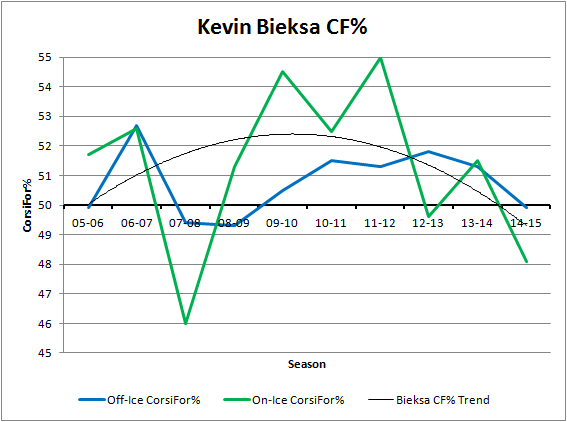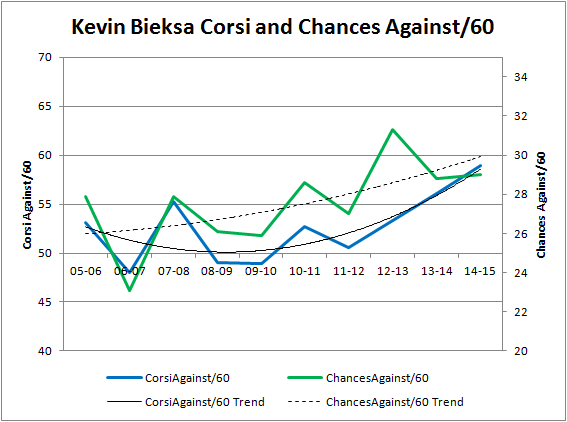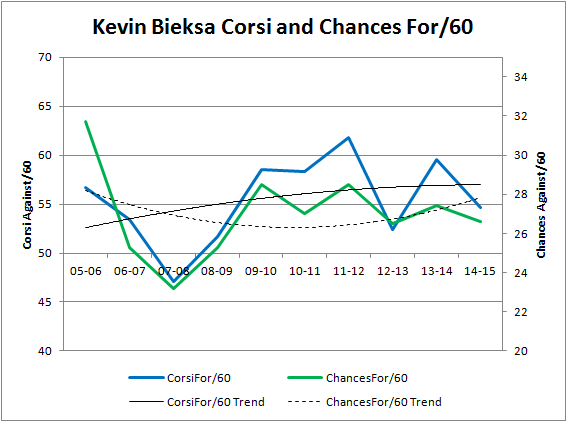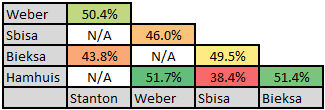More than halfway through the NHL season, the Vancovuer Canucks continued to have good luck with injuries. Sure, they’d lost Dan Hamhuis to a fluky leg injury and Zack Kassian to a broken finger for a short while, but they hadn’t exactly been the Columbus Blue Jackets in terms of an absolutely decimated roster. In fact, in terms of man-games lost to injury, the Canucks have been the 6th healthiest team in the NHL. Weighting for cap hit of injured players, they’ve been the 4th healthiest team.
This will take a hit in the upcoming weeks though, as Kevin Bieksa underwent surgery on a broken hand on Wednesday, meaning that he’ll be out of the lineup for the foreseeable future. Bieksa though has struggled at times this season and come under fire for his defensive deficiencies and casual appearance on the ice, leading some fans to question whether the Canucks will actually benefit from his absence.
Has Kevin Bieksa actually become so bad that Vancouver will be better without him? Let’s explore after the jump.
Bieksa in 2014-15
Currently sitting at a 48.1% Corsi, Kevin Bieksa is having the second worst season in terms of puck possession of his career, behind only 2007-2008. The 33-year old’s offensive output at 5-on-5 is also at the lowest it’s ever been in his NHL career, including as he has a career low 0.6 pts/60 and 0.3 assists/60 so far under Willie Desjardins. He also registered 0.6 pts/60 last year under John Tortorella, but much of that can probably be attributed to a low 6.8% on-ice shooting percentage. His puck luck at the offensive end of the rink has bounced back, but his scoring has remained consistently low, and slightly below what you’d expect from an average 2nd pairing D-man.

Despite his offensive struggles, the eye test seems to indicate that Bieksa’s defensive play has atrophied too. The numbers tend to support this, as his on-ice defensive results in terms of shot attempts and scoring chances against have been getting worse at a slightly faster rate than his on-ice offensive results have.


In terms of goals, Bieksa is 3rd worst on Vancouver in plus/minus at a -7, and his on-ice GoalsFor% is 3rd worst among regular Vancouver defenders at 44.8%. He’s also on pace to be a -55 in an 82-game season for scoring chances too, which would be the 3rd worst mark of his career.
However, a lot of Bieksa’s struggles can be attributed to playing most of this season with the worst defensive partners he’s ever shared the ice with in his NHL career. He’s spent most of his ice time with Ryan Stanton, with whom he’s posted an abysmal 43.5% Corsi, and Luca Sbisa, with whom he has a more respectable 49.5% Corsi but has hemorrhaged scoring chances to the point where they have a 37.5% GoalsFor percentage with one another.
Stanton has been tremendously disappointing despite our optimism going in to the year, but we know that Luca Sbisa probably shouldn’t be an NHL player based on how he’s performed in Philadelphia and Anaheim. Bieksa has really spent significant time with just one legitimate NHL defender in 2014-2015, and that’s been Dan Hamhuis. Together, they have a 51.5% Corsi in just over 150 minutes of 5-on-5 TOI.
We’ve established that Bieksa is worse in 2014-15 compared to what he once was, which is what we should expect from a 33-year old defender who’s put a lot of miles on his body by playing a rugged style for most of his career. But the question is “are the Canucks better off without him,” and for that we need to look at his potential replacements in the lineup.
Vancouver’s Depth
Below is a table of all possible combinations of bottom-4 D the Canucks had been using this season and the Corsi% of those pairings when together:

When healthy, it appears that Vancouver’s optimal combination is Hamhuis-Bieksa on pair two, and Stanton-Weber on the 3rd pair. A straight swap of Bieksa for Luca Sbisa on the second pairing basically kneecaps Hamhuis’ effectiveness, and it hurts Sbisa too. This probably has to do with two both guys being left-handed and used to playing the left side, forcing one out of position and out of their comfort zone, but it’s tough to explain definitively without any direct evidence. What we do know is that we don’t want Hamhuis-Sbisa to happen at any cost.
Sbisa-Weber hasn’t been particularly good either, and we also haven’t seen Sbisa-Stanton or Hamhuis-Stanton for any notable length of time. What seems clear is that Willie Desjardins desperately wants Ryan Stanton to play with a right-handed partner, and that Luca Sbisa with another lefty seems like a recipe for disaster. Fortunately, Vancouver has a very good collection of right-handed AHL talent down in Utica, Including Frank Corrado.
Young Corrado has looked good in his brief time with the Canucks this season, but he’s still fairly unproven at the NHL level. He’s a minus-10 for scoring chances in 4 games this season, but was plus-6 by the same measure in 15 games under John Tortorella. He’s also hovered around 50% Corsi in his first two glimpses at part-time NHL duty, and has been a solid contributor to the Utica Comets.
By all indications, Corrado seems to be ready for low-leverage, part-time NHL duty at the very least, but whether he’s a better than average NHL defenseman is a serious question. He may one day prove to be a serviceable top-4 guy, but that will probably come a year or two down the road. Corrado is a great unknown and may be deserving of a regular spot in the top-6, but asking him to replace a traditionally effective second-pairing guy is probably too much to expect right off the bat.
AHL All-Star Bobby Sanguinetti and the currently injured Alex Biega, who’s drawn rave reviews, are also possibilities if Corrado or Weber struggle, though neither has had a legitimate chance to prove that they’re NHL players in recent years. Biega hasn’t suited up for an NHL game at all, so who knows how he’d perform.
Conclusion
With Stanton stapled to the left side and Hamhuis back from injury, Vancouver’s right side D options with Bieksa out of the lineup are Luca Sbisa, who we know is bad in that role, Yannick Weber, and a whole bunch of unknowns. Bieksa is almost certainly not worse than Sbisa, and you can’t argue that Vancouver is better off without Bieksa unless you’re ready to make the argument that two of Corrado, Weber, Sanguinetti, or Biega are better hockey players than Bieksa is right now.
We do know that 2014-15 Kevin Bieksa is no longer prime-aged Kevin Bieksa, and so long as Luca Sbisa doesn’t find himself playing Right D, Vancouver’s right-handed farm depth should allow them to absorb an injury to Bieksa better than they were able to when Dan Hamhuis hit the IR. Still, suggesting that having one guy from a collection of guys that essentially have been AHL journeymen so far in their careers in your top-4 D is a really risky bet to make, even if one of those guys is arguably your top defensive prospect.
The Vancouver Canucks are very likely not a better team with Kevin Bieksa out of the lineup, but given his decline and the strong performances demonstrated by other right-handed guys on the farm, it’s also not entirely out of the question that they are better. However, that possibility seems very remote.

